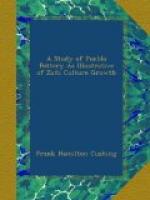Precisely in accordance with this theory were the studies of my preceptor, the lamented Prof. Charles Fred. Hartt. In a paper “On Evolution in Ornament,” published in several periodicals, among them the Popular Science Monthly of January, 1875, this gifted naturalist illustrated his studies by actual examples found on decorated burial urns from Marajo Island. I must take the liberty of suggesting, however, that upon some antecedent kind of vessel, the eyes of the Amazonian Islanders may have been, to give Professor Hartt’s idea, “trained to take physiological and aesthetic delight in regularly recurring lines and dots”; not on the pottery itself, as he seemed to think, for decoration was old in basketry and the textiles when pottery was first made.
DECORATIVE SYMBOLISM.
[Illustration: FIG. 545.—Food-bowl.
FIG. 546.—Water-jar.
(Showing
open or joined space in line near rim.)]
On every class of food- and water-vessels, in collections of both ancient and modern Pueblo pottery (except, it is important to note, on pitchers and some sacred receptacles), it may be observed as a singular, yet almost constant feature, that encircling lines, often even ornamental zones, are left open or not as it were closed at the ends. (See Figs. 545, a, 546, a.) This is clearly a conventional quality and seemingly of intentional significance. An explanation must be sought in various directions, and once found will be useful in guiding to an understanding of the symbolic element in Pueblo ceramic art. I asked the Indian women, when I saw them making these little spaces with great care, why they took so much pains to leave them open. They replied that to close them was a’k ta ni, “fearful!”—that this little space through the line or zone on a vessel was the “exit trail of life or being”, o’ ne yaethl kwai na, and this was all. How it came to be first left open and why regarded as the “exit trail,” they could not tell. If one studies the mythology of this people and their ways of thinking, then watches them closely, he will, however, get other clews. When a woman has made a vessel, dried, polished, and painted it, she will tell you with an air of relief that it is a “Made Being.” Her statement is confirmed as a sort of article of faith, when you observe that as she places the vessel in the kiln, she also places in and beside it food. Evidently she vaguely gives something about the vessel a personal existence. The question arises how did these people come to regard food-receptacles or water-receptacles as possessed of or accompanied by conscious existences. I have found that the Zuni argues actual and essential relationship from similarity in the appearance, function, or other attributes of even generically diverse things.[2]




